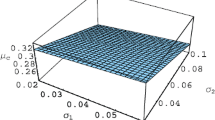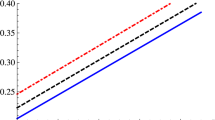Abstract
Electronegative dusty plasma composed of Boltzmann electrons, Boltzmann negative ions, inertial positive ions and charge fluctuating dust has been considered. The fractional modified Burgers’ (FMB) equation, which is derived using Euler–Lagrange variational technique, is analytically obtained and solved for studying the cylindrical geometry effect on the propagation of the dust ion acoustic shock wave. The Laplace homotopy perturbation method, the so-called LHPM is applied to solve the FMB equation. The effect of the fractional parameter, positive ion number density at equilibrium, the number of equilibrium electrons residing on the dust grain surface and shock velocity on the behavior of the shock waves in the dusty plasma has been investigated.






Similar content being viewed by others
References
P K Shukla and V P Silin Phys. Scr. 45 508 (1992)
A Barkan N D’Angelo and R L Merlino Planet. Space Sci. 44 239 (1996)
P Borah D Gogoi and N Das Phys. Scr. 91 015603 (2016)
D-N Gao Y R Ma Y Yang J Zhang and W-S Duan Indian J. Phys. 90 1313 (2016)
M A H Khaled Indian J. Phys. 88 647 (2014)
[6] A Saha and P Chatterjee Braz. J. Phys. 45 (4) 419 (2015)
A Saha and P Chatterjee Phys. Plasmas 20 (2) 022111 (2013)
G Mandal K Roy and P Chatterjee Indian J. Phys. 83 365 (2009)
N N Rao P K Shukla and M Y Yu Planet. Space Sci. 38 543 (1990)
A Barkan R L Merlino and N D’Angelo Phys. Plasmas 2 3563 (1995)
H Alinejad Phys. Lett. A 375 1005 (2011)
S K El-Labany W F El-Taibany and M Mahmoud Phys. Scr. 87 055502 (2013)
P K Shukla and A A Mamun Introduction to Dusty Plasma Physics (Bristol: Institute of Physics Publishing Ltd.) (2002)
A A Mamun P K Shukla and B Eliasson Phys. Plasmas 16 114503 (2009)
S H Kim and R L Merlino Phys. Plasmas 13 052118 (2006)
M Rosenberg R L Merlino Planet. Space Sci. 55 1464 (2007)
A A Mamun R A Cairns and P K Shukla Phys. Lett. A 373 2355 (2009)
M Larsson W D Geppert and G Nyman Rep. Prog. Phys. 75 066901 (2012)
E C Whipple T G Northrop D A Mendis and J. Geophys. Res. 90 7405 (1985)
P K Shukla and B Eliasson Rev. Mod. Phys. 81 25 (2009)
G E Morfill and A V Ivlev Rev. Mod. Phys. 81 1353 (2009)
A A Mamun P K Shukla and B Eliasson Phys. Rev. E 80 046406 (2009)
A A Mamun and S Tasnim Phys. Plasmas 17 073704 (2010)
M S Zobaer, K N Mukta, L Nahar, N Roy and A A Mamun Phys. Plasmas 20 043704 (2013)
S A El-Wakil, E M Abulwafa, E K El-Shewy and A A Mahmoud Phys. Plasmas 18 092116 (2011).
S Guo, L Mei and Z Zhang Phys. Plasmas 22 052306 (2015)
A Nazari-golshan and S S Nourazar Phys. Plasmas 20 103701 (2013)
A Nazari-golshan, S S Nourazar, P Parvin and H Ghafoori-Fard Astrophys. Space Sci. 349 205 (2014)
S A El-Wakil, E M Abulwafa, A Elgarayhi, E K El-Shewy, A A Mahmoud and A M Tawfik Astrophys Space Sci. 350 591 (2014)
A Nazari-golshan Phys. Plasmas 23 082109 (2016)
H Schamel J. Plasma Phys. 9 377 (1973)
S Maxon and J Vievelli Phys. Rev. Lett. 32 4 (1974)
O P Agrawal J. Math. Anal. Appl. 337 1 (2008)
S I Muslih and O P Agrawal Int. J. Theor. Phys. 49 270 (2010)
O P Agrawal J. Phys. A Math. Theor. 40 6287 (2007)
S G Samko, A A Kilbas and O I Marichev Fractional Integrals and Derivatives: Theory and Applications (New York: Gordon and Breach) (1998)
I Podlubny Fractional Differential Equations (Academic Press, San Diego) (1999)
S S Nourazar M Soori and A Nazari-Golshan Aust. J. Basic Appl. Sci. 5 1400 (2011)
A Nazari-Golshan, S S Nourazar, H Ghafoori-Fard, A Yildirim and A Campo Appl. Math. Lett. 26 1018 (2013)
S S Nourazar A Nazari-Golshan Indian J. Phys. 89 61 (2015)
G Adomian, Solving Frontier Problems of Physics: The Decomposition Method (Boston: Kluwer) (1994)
S S Nourazar, A Nazari-Golshan, A Yildirim and M Nourazar Z. Naturforsch. 67a 355 (2012)
J H He Commun. Nonlinear Sci. Numer. Simul. 2 230 (1997)
S S Nourazar A Nazari-Golshan and M Nourazar Phys. Int. 2 8 (2011)
Z Zhang Turk. J. Phys. 32 235 (2008)
Z Zhang, Y Li, Z Liu and X Miao Commun. Nonlinear Sci. Numer. Simul. 16 (8) 3097 (2011)
Z Zhang, Z Liu, X Miao and Y Chen Phys. Lett. A 375 1275 (2011)
Z Zhang, X Gan, and D Yu Z. Naturforsch. 66a 721 (2011)
Z Zhang, F Xia and X Li Pramana 80 (1) 41(2013)
X Miao and Z Zhang Commun. Nonlinear Sci. Numer. Simul. 16 (11) 4259 (2011)
Z Zhang, J Huang, J Zhong, S Dou, J Liu, D Peng and T Gao Pramana 82 (6) 1011 (2014)
Z Zhang and J Wu Opt. Quantum Electron. 49 1 (2017)
Z Zhang, J Huang, J Zhong, S S Dou, J Liu, D Peng and T Gao Rom. J. Phys. 58 (7) 749 (2013)
Z Zhang Rom. J. Phys. 9 1384 (2015)
Z Zhang, X Gan, D Yu, Y Zhang and X Li Commun. Theor. Phys. 57 764 (2012)
Z Zhang Turk. J. Phys. 37 259 (2013)
Z Zhang, Y Zhang, X Gan and D Yu Zeitschrift fur Naturforschung 67a 167 (2012).
Z Zhang, Z Liu, X Miao and Y Chen Appl. Math. Comput. 216 3064 (2010)
Z Zhang, J Huang, J Zhong, S S Dou, J Liu, D Peng and T Gao Rom. J. Phys. 65 (4) 1155 (2013)
A J Coates, F J Crary, G R Lewis, D T Young, J H Waiter and E C Sittler Geophys. Res. Lett. 34 L22103 (2007)
G Adomian Nonlinear Stochastic Operator Equations. (San Diego: Academic Press) (1986)
J H He Int. J. Turbo Jet-Engines 14 23 (1997)
J H He Chaos Solitons Fractals 19 847 (2004)
Author information
Authors and Affiliations
Corresponding author
Appendices
Appendix A: Fractional modified Burgers’ equation solution
The general form of one-dimensional nonlinear partial differential equations is considered to illustrate the basic idea of Laplace transform homotopy perturbation method:
where \( L \) and \( N \) denote a linear and a nonlinear operators respectively. We construct a homotopy as follows:
Taking the Laplace transform from both sides of Eq. (A2):
where \( {\mathcal{L}} \) denotes the Laplace transform.
For the linear and nonlinear operators in Eq. (A3), the concept of the homotopy perturbation method with embedding parameter \( p \) is used to generate a series expansion for \( L\left( {u\left( {x,t} \right)} \right) \) and \( N\left( {u\left( {x,t} \right)} \right) \) as follows [41, 61]:
where, the components \( u_{i} , i \ge 0 \) are to be determined in a recursive manner, the Adomian polynomials, \( H_{i} \), are expressed as:
By substituting Eq. (A4) into Eq. (A3):
On the other hand, Eq. (A6) can be rewritten in the following manner:
Using Eq. (A7), we introduce the recursive relations as:
Using the Maple symbolic code, the first part of Eq. (A8), \( p^{0} \), gives the value of \( {\mathcal{L}}\left\{ {u_{0} } \right\} \). First, applying the inverse Laplace transform to \( {\mathcal{L}}\left\{ {u_{0} } \right\} \) gives the value of \( u_{0} , \) that will define the Adomian polynomial, \( H_{0} \) using the first part of Eq. (A5). In the second part Eq. (A8), the Adomian polynomial \( H_{0} \) will enable us to evaluate \( {\mathcal{L}}\left\{ {u_{1} } \right\} \). Second, applying the inverse Laplace transform to \( {\mathcal{L}}\left\{ {u_{1} } \right\} \) gives the value of \( u_{1} , \) that will define the Adomian polynomial \( H_{1} \) using the second part of Eq. (A5) and so on. This in turn will lead to the complete evaluation of the components of \( u_{k} , k \ge 0 \) upon using different corresponding parts of Eqs. (A8) and (A5). Therefore, the series solution follows immediately after using the first part of Eq. (A4) with embedding parameter \( p = 1 \).
Appendix B: Fractional modified Burgers’ equation
Using the potential function, \( \Upsilon \left( {\xi ,\tau } \right) \), where the \( \varphi_{1} =\Upsilon _{\xi } \), gives the potential equation of the modified Burgers’ equation, Eq. (10), in the form:
The functional of the Eq. (B1) can be represented [62, 63]:
Where \( a_{1} , a_{2} , a_{3} \) and \( a_{3} \) are unknown constants to be determined. Integrating this equation by parts where \( \left. {\Upsilon_{\tau } } \right|_{\text{R}} = \left. {\Upsilon_{\xi } } \right|_{\text{T}} = 0 \) gives:
Taking the first variations for this equation with respect to the dependent variable,\( \Upsilon \), and assuming that \( \varphi_{1} \) is a fixed function lead to,
So, according to the Eq. (B2), the Lagrangian of FMB equation, Eq. (B3), is given by
According to Eq. (B5), the Lagrangian of FSE can be written as:
where the left Riemann–Liouville fractional derivative \( {}_{0}^{{}} D_{\tau }^{\alpha } \) is reperesented by [36, 37]
The Laplace transform of the fractional derivative, \( {}_{a}^{{}} D_{t}^{\alpha } f\left( t \right) \), is given by:
The functional of the time fractional potential equation can be represented in the form,
where the time-fractional Lagrangian is defined by (B6).
Taking the first variations of Eq. (B9) with respect to the \( \Upsilon \) leads to:
Integrating by parts lead to:
Here we assume that \( \updelta\Upsilon {\mid }_{\text{T}} =\updelta\Upsilon |_{\text{R}} =\updelta\Upsilon_{\upxi} {\mid }_{\text{R}} = 0. \)
Optimizing Eq. (B11), \( \updelta{\text{J}}\left( \Upsilon \right) = 0 \), gives the following Euler–Lagrange equation:
Substituting from the Lagrangian equation, Eq. (B6), into Euler–Lagrange formula, Eq. (B12), and making use of Eq. (14) and \( \varphi_{1} = \Upsilon_{\xi } \) lead to the FMB equation, Eq. (13).
Rights and permissions
About this article
Cite this article
Nazari-Golshan, A. Investigation of cylindrical shock waves in dusty plasma. Indian J Phys 92, 1643–1650 (2018). https://doi.org/10.1007/s12648-018-1260-y
Received:
Accepted:
Published:
Issue Date:
DOI: https://doi.org/10.1007/s12648-018-1260-y
Keywords
- Dust ion acoustic waves
- Shock wave
- Laplace transforms homotopy perturbation method
- Fractional modified Burgers’ equation
- Negative ions




